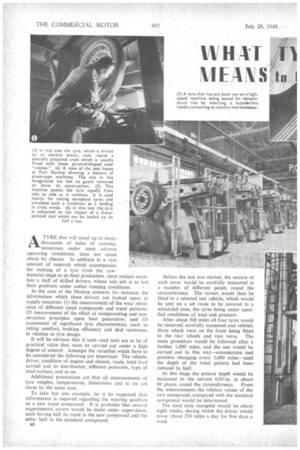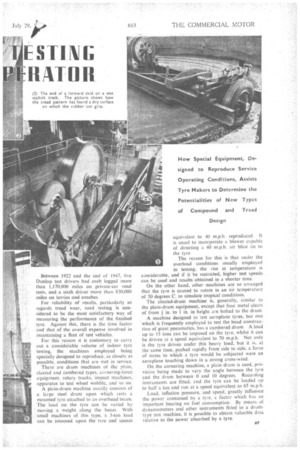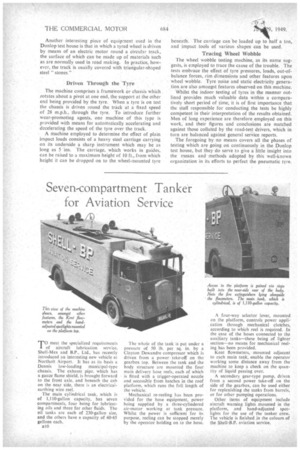A TYRE that will stand up to many thousands of miles
Page 16

Page 17

Page 18

If you've noticed an error in this article please click here to report it so we can fix it.
of running, sometimes under most adverse operating conditions, does not come about by chance. In addition to a vast amount of research which accompanies the making of a tyre from the raw
material stage to its final production, most makers maintain a staff of skilled drivers, whose sole job is to test their products under actual running conditions.
In the case of the Dunlop concern, for instance, the information which these drivers are looked upon to supply concerns: (1) the measurement of the wear resistance of different tread compounds and tread patterns; (2) measurement of the effect of compounding and construction principles upon heat generation; and (3) assessment of significant tyre characteristics, such as riding comfort, braking efficiency and skid resistance, in relation to tyre design.
It will be obvious that if such road tests are to be of practical value they must be carried out under a high degree of control Amongst the variables which have to be considered the following are important: The vehicle, driver, condition of engine and chassis, route, total load carried and its distribution, inflation pressures, type of road surface, and so on.
Additional precautions are that all measurements of tyre weights, temperatures, dimensions and so on are made by the same man.
To take but one example, let it be supposed that information is required regarding the wearing qualities of a new tread compound. It is probable that several experimental covers would be made under supervision, each having half its tread in the new compound and the other half in the standard compound.
B8
Before the test was started, the section of each cover would be carefully measured at a number of different points round the circumference. The covers would then be .fitted to a selected test vehicle, which would be sent on a set route to be covered in a scheduled time, the tyres being under specified conditions of load and pressure.
After about 500 miles all four tyres would be removed, carefully examined and refitted, those which were on the front being fitted to the rear wheels and vice versa. The same procedure would be followed after a further 1,000 miles, and the test would be carried out in this, way—examination and position changing every 1,000 miles—until the depth of the tread pattern had been reduced by half.
At this stage the pattern depth would be measured to the nearest 0.01-in, in about 80 places round the circumference. From the measurements the relative values of the new compound, compared with the standard compound would be determined.
The total time occupied would be about eight weeks, during which the driver would cover about 230 miles a day for five days a week Between 1922 and the end of 1947, live Dunlop test drivers had each logged more than 1,170,000 miles on private-car road tests, and a sixth driver more than 830,000 miles on lorries and coaches
For reliability of results, particularly as regards tread wear, road testing is considered to be the most satisfactory way of measuring the performance of the finished tyre. Against this, there is the time factor and that of the overall expense involved in maintaining a fleet of test vehicles.
For this reason it is customary to carry out a conside-rable volume of indoor tyre testing, the machines employed being specially designed to reproduce, as closely as possible, conditions that are met in service.
There are drum machines of the plain, cleated and cambered types, co nering-force equipment, rotary tracks, impact machines, apparatus to test wheel wobble, and so on.
A plain-drum machine usually consists of a large steel drum upon which rests a mounted tyre attached to an overhead beam. The load on the tyre can be varied by moving a weight along the beam With .,smait machines of this type, a 3-ton load can be imposed upon the tyre and speeds
equivalent to 40 m.p.h. reproduced. It is usual to incorporate a blower capable of directing a 40 m.p.h. air blast on to the tyre.
The reason for this is that under the overload conditions usually employed in testing, the rise in temperature is considerable, and if it be restricted, higher test speeds can be used and results obtained in a shorter time.
On the other hand, other machines are so arranged that the tyre is caused to rotate in an air temperature of 50 degrees C. to simulate tropical conditions.
The cleated-drum machine is, generally, similar to the plain-drum equipment, except that four metal cleats of from k in. to 1 in. in height are bolted to the drum.
A machine designed to test aeroplane tyres, but one \ which is frequently employed to test the bead construction of giant pneumatics, has a cambered drum. A load up to 15 tons can be imposed on the tyre, wbilst it can be driven at a speed equivalent to 70 m.p.h. Not only is the tyre driven under this heavy load, but it is, at the same time, pushed rapidly from side to side, a form of stress to which a tyre would be subjected were an aeroplane touching down in a strong cross-wind.
On the cornering machine-, a plain drum is used, provision being made to vary the angle between the tyre and the drum between 0 and 10 degrees. Recording instruments are fitted, and the tyre can be loaded up to half a ton and run at a speed equivalent to 65 m.p.h.
Load, inflation pressure, and speed, greatly influence the power consumed by a tyre, a (actor which has an important bearing on fuel consumption. By means of dynamometers and other instruments fitted to a drurntype test machine, it is possible to obtain valuable data relative to the power absorbed by a tyre. Another interesting piece of equipment used in the Dunlop test house is that in which a tyred wheel is driven by means of an electric Motor round a circular track, the surface of which can. be made up of materials Such as are normally used in road making. In practice, however, the track is usually covered with triangular-shaped steel "stones" Driven Through the Tyre
The machine comprises a framework or chassis which rotates about a pivot at one end, the support at the other end being provided by the tyre. When a tyre is on test the chassis is driven round the track at a fixed speed of 28 mph., through the tyre. To introduce further wear-promoting agents, one machine of this type is provided with means for automatically accelerating and decelerating the speed of the tyre over the track.
• A machine employed to determine the effect of plain impact loads consists of a heavy steel carriage carrying on its underside a sharp instrument which may be as long as 5 'ins. The carriage, which works in guides, can be raised to a maximum height of 10 ft., from which height it can be dropped on to the wheel-mounted tyre beneath. The carriage can be loaded up to half a ton, and impact tools of various shapes can be used.
Tracing Wheel Wobble The wheel wobble testing machine, as its name suggests, is employed to trace the cause of the trouble. The tests embrace the effect of tyre pressures, loads, out-ofbalance forces, rim dimensions and other features upon wheel wobble. Tyre noise and static electricity generation.are also amongst features observed on this machine.
Whilst the indoor testing of tyres in the manner outlined provides much valuable data within a comparatively short period of time, it is of first importance that the staff responsible for conducting the tests be highly competent in their interpretation of the results obtained. Men of long experience are therefore employed on this work, and their figures and conclusions are matched against those collated by the road-test drivers, which in turn are balanced against general service reports.
The foregoing by no means covers all the phases of testing which are going on continuously in the Dunlop test house, but they do serve to give a little insight into the means and methods adopted by this well-known organization in its efforts to perfect the pneumatic tyre.


























